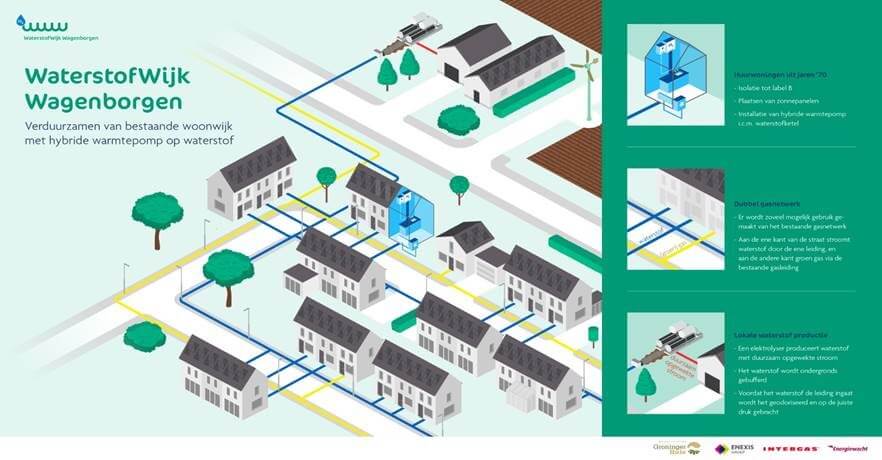First 1970s residential neighborhood transitions to hydrogen
Enexis Group and housing foundation Groninger Huis are launching a unique project by connecting a 1970s residential neighborhood in Wagenborgen (Groningen) to a hydrogen network. Of the 40 residents approached in this area, nearly all have now agreed to participate in the project, named Hydrogen District Wagenborgen. This project demonstrates that hydrogen, alongside residual heat, green gas, and all-electric solutions, is one of the viable options for gas-free living.
The use of hydrogen to heat existing older homes is a technology still in its infancy worldwide. On behalf of Groninger Huis, Energiewacht is insulating these homes to energy label B before the hydrogen pipeline is installed. The homes will be heated using a hybrid heat pump from Intergas, which will also be maintained by Energiewacht. This hybrid heat pump runs primarily on sustainably generated electricity, and hydrogen is used during colder periods. The homes will be equipped with solar panels, and residents will switch to induction cooking. The project is further supported by a local agricultural company that produces and stores the hydrogen. Through this initiative, the participating parties are gaining essential experience for the energy transition.
Communication with residents is a unique aspect of this project. “Our residents made this project possible. Without them, there would be no project,” says Laura Broekhuizen, director of Groninger Huis. “We selected forty homes, personally explained the project and its implications to the residents, and asked if they wanted to participate. We’re truly proud to have sufficient participation and to be contributing together to a sustainable future.” Groninger Huis is also involved in another project in Wagenborgen: . This initiative offers other tenants and homeowners the opportunity to switch to green gas.
A unique project
Wagenborgen is home to the first hydrogen residential project in the Netherlands located in a 1970s neighborhood. “With this pilot in an older residential area, we are gaining experience, together with residents and participating parties on how best to make homes more sustainable using hydrogen, while making maximum use of the existing gas pipelines,” says Sybe bij de Leij, innovation manager at Enexis Group.
Meindert Joostens, sustainability alderman for the municipality of Eemsdelta, adds: “The municipality of Eemsdelta is positive about the project and is happy to support it. This is important for long-term exploration in the search for new energy sources. For a successful energy transition, public support is crucial. That’s why we’re pleased that 30 families have already signed up for the pilot. Collaboration between various parties and residents is key to success, and this unique project is a great example of that.”
Sustainably produced hydrogen is CO₂-neutral. Its application in the built environment appears to hold significant potential, but further research is needed. Large-scale experience with the production, distribution, and use of hydrogen is still lacking. Therefore, grid operators advocate focusing on the development and use of hydrogen in industry and selected projects within the built environment until 2030.
Hydrogen as part of the energy transition
The reduction of natural gas consumption is accelerating in the coming years. The goal is to make 200,000 homes gas-free annually, for example by switching to green gas, an electric heat pump (hybrid or all-electric), or a district heating system. In the future, hydrogen could be a valuable addition to this range of options. Gaining experience collectively is essential. This goes beyond just the gas network operators and also involves appliance suppliers, safety authorities, municipalities, and other government bodies. In the implementation of the Climate Agreement, the use of hydrogen is a key focus for grid operators.
